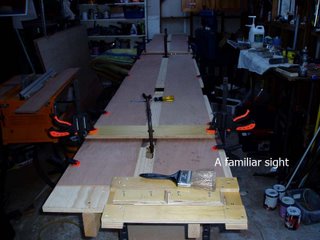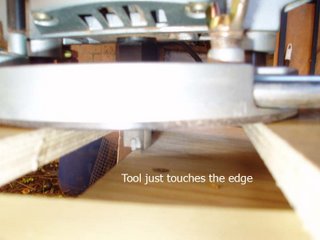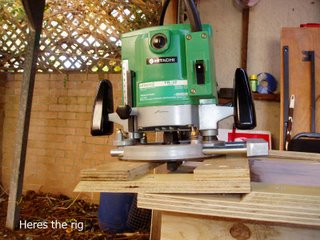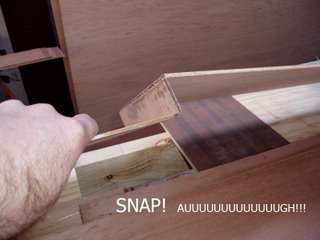I turned a disater on its head :-)

This about sums up my day today.
Blue funk to start with, smiles at the end!
Producing!


After a bit of tuning I was getting very even and more impotantly SQUARE bevels. I spent the rest of the day breaking my planks and scarfing them over again.
I have had a breakthrough on this project by doing these procedures over again. I have made a deal with myself not to give up on this when things are frustrating.
After I did all the scarfs over, I laid out two 10" planks, glued and clamped them. I cut a hole in the bench with the router (then a hole saw then a chisel) so that I could set up a center clamp. It worked a treat and the scarfs were really nice looking.
Let's go scarfin now, everybody's learnin' how...


I tested the new jig on some scrap and then progressed to some pieces I intend to use for extending the bottom planks. I progressed onto the 11" planks and then the 10 inchers. An important part of the jig was the clamping block. I slips under the back crossmember on top of the workpiece to clamp it evenly and flat.
A jig or a sea shanty?



The frame sits on the end of the bench. I needed it to overhang enough so that the tool wouldn't be over half way into the ply on the first pass. I could only achieve this with the frame ovehanging about 12mm. The first pass would be done with the fence up against the top cross member of the frame. The tool had to just touch the edge of the bench to achieve the fine edge needed for a good bevel. I put two screws through the short sections, close to the edge. Then, after backing them out a few turns, I got a couple of chamfered blocks to tilt the router table. I tool an 11" palnk and marked the 1 and 1/4" line where the bevel should span. I pushed the plank up to the edge and then tilted the table so that the top of the wedge shaped gap that opened up, lined up with the mark on the plank. This is how I knew that I would be able to make a correctly dimensioned bevel.
To finish, I tightened up the two screws and drove two long screws through the joint at the back edge to clamp the router table down to the tilting blocks.
The tilting blocks doubled up as guides for the 11" planks. I decided that I'd put in two additional guides further down the bench and then move one of those when I was dealing with the 10" planks.
The new deal

After accepting that I had made a howling error on the lap scarfs (it took a day to let it sink in) I returned to the builders manual to learn about bevel scarfing. I tried a couple with my block plane and got reasonable results but I thought I could speed up the process by returning to the trusty router. To this end I devised a new jig to cut bevels. I wanted to build some thing I could leave set up, just in case I forgot a couple (like I did on the previous attempt). Here, I am starting out with some 12mm ply that I salvaged from my old kitchen. It's all made from this ply, ripped to 60mm the long sides will acommodate the 11" planks between the two shorter pieces. It's important to keep the whole jig as square as possible during construction. This will simplify the setup and tuning later on.
Disaster!!!

So here i was thinking "Great! I've finished all my scarfing, time to get into the lofting!" So I get one of my 10 inch wide planks and manhandle it onto the table. I'm almost there when, SNAP! My carefully made and smoothed scarf joint snaps! AUUUUUGH! As Charlie Brown would say. At this point I had a choice to make. Would I test my other scarfs? maybe this is a one off. So I tested another one, it snapped too. I remember my Dad suggesting I do the scarfs this way instead of using the bevel. "Why?" I asked, "because its stronger" came the authoritative reply. Stronger = Better as far as i'm concerned. So off I went.
Some background on the lap-scarfs.
My Dad and I built a 37 ft fiberglass yacht together. We built it from scratch. Starting with a rectangle pegged out in the back yard we built a shed, a strongback (for setting the frames on) and then proceeded to construct a male mould and laminate it with fiberglass. So far so good. When Dad came to the bulkheads, he had to scarf three sheets of ply to make something wide enough. He used a lap-scarf rather than a bevel. I can see now, why he did. A lap scarf is easy to make with a router, it's self aligning and it's neat. But wait, there are no bending loads on the bulkhead, mainly torsional. Plus, the whole thing was laminated with fiberglass, making the ply a core rather than a sole load bearing structure.
The ply in the LT 17 is a core too but it is subject to bending stresses during construction and in service. Bevel scarfs make much more sense in this situation. Look at my laps. As soon as the resin bond fractures on the butt end of the scarf, the material becomes half as thick at the next point of failiure. At which pint 4mm ply will break easily along the line cut by the router. In other words DISASTER!
More Scarfing

More scarfing. I have abandoned the buckets of water (stupid idea!) and I am now doing only two scarfs at a time. I know the build manual says to stack 'em up and do a heap together but I like taking my time with it. These are the topside planks so next will be the lofting stage. I still don't have a batten for marking out the curves but theres a ton of timber yards here so I should be able to scare something up.



 After a bit of tuning I was getting very even and more impotantly SQUARE bevels. I spent the rest of the day breaking my planks and scarfing them over again.
After a bit of tuning I was getting very even and more impotantly SQUARE bevels. I spent the rest of the day breaking my planks and scarfing them over again.



 The frame sits on the end of the bench. I needed it to overhang enough so that the tool wouldn't be over half way into the ply on the first pass. I could only achieve this with the frame ovehanging about 12mm. The first pass would be done with the fence up against the top cross member of the frame. The tool had to just touch the edge of the bench to achieve the fine edge needed for a good bevel. I put two screws through the short sections, close to the edge. Then, after backing them out a few turns, I got a couple of chamfered blocks to tilt the router table. I tool an 11" palnk and marked the 1 and 1/4" line where the bevel should span. I pushed the plank up to the edge and then tilted the table so that the top of the wedge shaped gap that opened up, lined up with the mark on the plank. This is how I knew that I would be able to make a correctly dimensioned bevel.
The frame sits on the end of the bench. I needed it to overhang enough so that the tool wouldn't be over half way into the ply on the first pass. I could only achieve this with the frame ovehanging about 12mm. The first pass would be done with the fence up against the top cross member of the frame. The tool had to just touch the edge of the bench to achieve the fine edge needed for a good bevel. I put two screws through the short sections, close to the edge. Then, after backing them out a few turns, I got a couple of chamfered blocks to tilt the router table. I tool an 11" palnk and marked the 1 and 1/4" line where the bevel should span. I pushed the plank up to the edge and then tilted the table so that the top of the wedge shaped gap that opened up, lined up with the mark on the plank. This is how I knew that I would be able to make a correctly dimensioned bevel.

 More scarfing. I have abandoned the buckets of water (stupid idea!) and I am now doing only two scarfs at a time. I know the build manual says to stack 'em up and do a heap together but I like taking my time with it. These are the topside planks so next will be the lofting stage. I still don't have a batten for marking out the curves but theres a ton of timber yards here so I should be able to scare something up.
More scarfing. I have abandoned the buckets of water (stupid idea!) and I am now doing only two scarfs at a time. I know the build manual says to stack 'em up and do a heap together but I like taking my time with it. These are the topside planks so next will be the lofting stage. I still don't have a batten for marking out the curves but theres a ton of timber yards here so I should be able to scare something up.